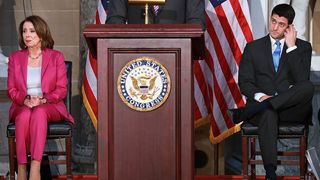Primary season is now underway in the United States, with Democrats hoping a blue wave will carry them to majorities in both the House and the Senate. They have good reason for that hope: opposition parties do well in midterm elections, a wave of Republican office-holders are resigning or retiring, and Donald Trump has hazardously low approval ratings.
Yet despite these favourable tailwinds, political analysts have advanced two theories about why Democrats are actually going to blow it in November: they have no agenda other than opposition to Trump, and they are lurching too far to the left. The first is hogwash – the Democrats have a clear and robust platform on everything from guns to health care and taxes to wages. But the second raises key questions about the party and the country as America approaches its first national election since 2016.
Political analysts have advanced two theories about why Democrats are actually going to blow it in November: they have no agenda other than opposition to Trump, and they are lurching too far to the left.
Call it the Democrats' tea-party problem: left-wing activists challenging establishment Democrats, costing them winnable elections. It was a dynamic that plagued the GOP from 2010 to 2016, drawing the party further to the right while elevating political neophytes who, it turned out, weren't capable of running competent campaigns. Republicans lost out on a number of opportunities to wrest control of the Senate from Democrats thanks to these candidates, and some within the Democratic Party worry the same could happen to them in 2018.
Some of the same dynamics that fuelled the tea party are indeed at play among Democrats this year. The Democratic Congressional Campaign Committee (DCCC), which works to elect Democrats to the House of Representatives, has spent the winter and spring warning off progressive candidates, picking the safest figures in each race to support. Just as in 2010, the races are shaping up as establishment versus outsider. And they're being fought tooth and nail: the DCCC launched a "scorched earth" attack against progressive candidate Laura Moser in a crowded Texas primary (Moser nonetheless advanced to the runoff election).
But that framing can disguise how much populist and establishment candidates share in common. In my home district in Virginia, four Democrats vied for the nomination. The DCCC backed Roger Dean Huffstetler, who was ultimately (and easily) defeated by one of his progressive challengers, Leslie Cockburn. But while Cockburn's politics are to the left of Huffstetler's, the distance between them is fairly small. Huffstetler preferred a higher regional minimum wage, Cockburn a national one; Huffstetler supported a Democratic health-care expansion called Medicare X, Cockburn supported Bernie Sanders' Medicare for All. These are differences, and they matter, but this is hardly a debate between moderate and radical factions.
Despite the tea-party rallying cry that Americans were taxed enough already, the recent Republican tax cut was deeply unpopular. What is popular: the Democratic plan to raise taxes on wealthier Americans, which more than three-quarters of Americans support.
Another key difference separates the growing Democratic wave from the GOP tea party: the Democratic agenda is surprisingly popular. Take the proposal to raise the federal minimum wage, which currently sits at a measly $7.25 an hour. The majority of Americans support raising it to $15 an hour – a major part of the Sanders campaign – and an even larger majority supports a higher minimum wage based on cost of living — a major part of the Clinton campaign.
Or look at gun control. The GOP position, which calls for guns to be less regulated, is deeply unpopular. Meanwhile, nearly 70 percent of Americans support stricter gun control regulations put forward by Democrats.
And despite the tea-party rallying cry that Americans were taxed enough already, the recent Republican tax cut was deeply unpopular. What is popular: the Democratic plan to raise taxes on wealthier Americans, which more than three-quarters of Americans support.
Democrats need to have a popular platform, because out-of-control Republican gerrymandering means they will have to win the popular vote in 2018 by as much as 11 points in order to win the majority of House seats. And the rash of voter restriction laws passed in the past decade make that even more of an uphill climb.
There is one tea-party problem the Democrats will face, even with their popular agenda. Should they win majorities in Congress, they will still have to govern. And even without the Republicans' dysfunctional coalition dynamics, that is still a tall order. For one, until 2021 the White House will be under Republican control, meaning the president will have the ability to veto any legislation that passes through Congress. But even passing something through Congress will be difficult, as routine filibuster motions have made it so that laws that should require a bare majority now need 60 votes to pass.
Add in a cut-throat partisanship that makes it unlikely any Republicans will crossover to vote for compromise measures, and the Democrats will need to have a strict party unity that can be difficult to manage in a diverse coalition (though Nancy Pelosi managed it in her time as Speaker from 2007 to 2011 – one reason she might return as speaker if Democrats win a majority, despite progressive opposition to her).
A blue wave is not inevitable. But the challenges Democrats face are often misdiagnosed as media outlets look to make the story of the election one of process and dysfunction rather than the fairly straightforward story of a party with a popular agenda against an unpopular president looking to overcome some structural challenges. It's a less sexy story, but a far more accurate one.






